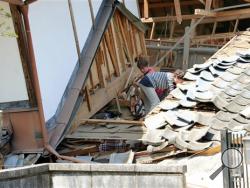MASHIKI, Japan (AP) — Aftershocks rattled communities in southern Japan as businesses and residents got a fuller look Friday at the widespread damage from an unusually strong overnight earthquake that killed nine people and injured about 800.
Rescue workers were combing through the wreckage in hard-hit areas to make sure there were no more trapped people, said Shotaro Sakamoto, a Kumamoto prefecture official. Concern about aftershocks was keeping many people from starting the huge task of cleaning up, police said.
Prime Minister Shinzo Abe told reporters the government wants to prevent any secondary disasters from aftershocks.
The magnitude 6.5 quake struck at 9:26 p.m. Thursday at a depth of 11 kilometers (7 miles) near Kumamoto city on the island of Kyushu, the southernmost of Japan's four main islands.
About 44,000 people evacuated their homes and stayed in shelters overnight. Many left the next day, but Sakamoto said he wasn't sure if many would come back to stay another night, depending on the conditions of their homes and if power is restored.
In the hardest-hit town of Mashiki, about 15 kilometers (9 miles) from the center of Kumamoto city, entire buildings collapsed, roofs slid off, and windows and walls crumbled, scattering glass and debris.
Huge boulder-like rocks tumbled from the walls of historic Kumamoto castle, which was closed to the public Friday.
Five women and four men were killed, the Fire and Disaster Management Agency said. One man in his 20s died; the rest of the victims ranged from their 50s to one woman in her 90s. Eight of the nine victims were from Mashiki.
There were varying reports on the number of injured. The government's chief spokesman, Yoshihide Suga, said at least 860 people had been injured, 53 seriously. Kumamoto prefecture tallied 784 injured.
Suga said 1,600 soldiers had joined the relief and rescue efforts. TV reports showed troops delivering blankets and adult diapers to those who took shelter.
The area is 1,300 kilometers (800 miles) southwest of Tokyo.
Rescue efforts, repeatedly disrupted by more than 100 aftershocks, continued through the night. Japanese television showed a baby wrapped in a blanket being carried out of the rubble of a home.
Electricity and water service was cut off in some area, and some residents were hauling water from local offices to their homes to flush toilets.
TV broadcasters were urging residents to check on elderly people living alone who might not have been able to escape their homes unaided.
Suga said there were no abnormalities at nearby nuclear facilities. The epicenter was 120 kilometers (74 miles) northeast of Kyushu Electric Power Co.'s Sendai nuclear plant, the only one operating in the country.
Most of Japan's nuclear reactors remain offline following the meltdowns at the Tokyo Electric Power Co.'s Fukushima plant in 2011 after a magnitude 9.0 earthquake triggered a huge tsunami.
According to the Japan Meteorological Agency, Mashiki sits near two faults on Kyushu. The area is also near Mount Aso, a huge, active volcano. JMA officials said the quake was unusually strong for Kyushu.
___
Associated Press writer Mari Yamaguchi in Tokyo contributed to this story.

